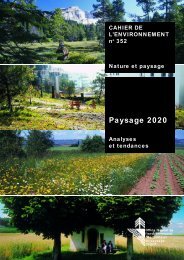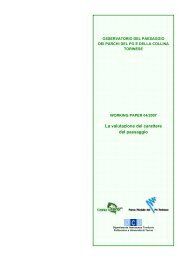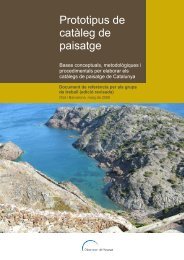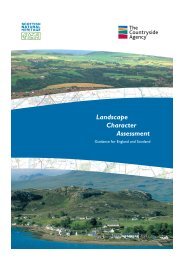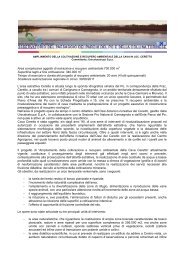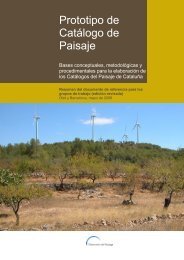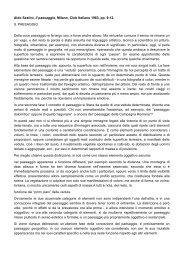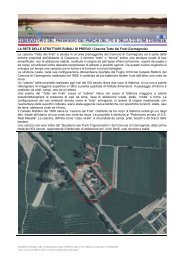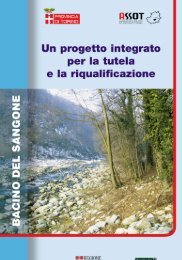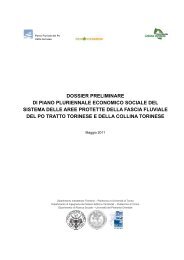Using Historic Landscape Characterisation
Using Historic Landscape Characterisation
Using Historic Landscape Characterisation
You also want an ePaper? Increase the reach of your titles
YUMPU automatically turns print PDFs into web optimized ePapers that Google loves.
Partnership, Learning and Outreach<br />
To ensure the greatest possible use of<br />
HLC information, its reports and the<br />
results of additional interpretations and<br />
research projects need to be widely<br />
available to the general public and<br />
students as well as to agencies,<br />
organisations and consultants. Some<br />
counties have ensured that copies of<br />
their final project reports are sent to<br />
local libraries, so that reference copies<br />
are easily accessible.<br />
Local authority Internet sites are a<br />
useful means of providing and<br />
accessing this information. The<br />
Hampshire HLC report is available<br />
online along with map extracts and<br />
charts that show the HLC profile of<br />
parishes across the county<br />
(www.hants.gov.uk/landscape).<br />
In Lancashire the HLC report is also<br />
available online at<br />
www.lancashire.gov.uk/environment/<br />
archaeology/lhlcp/index.asp, and on a<br />
CD-ROM that includes the GIS data<br />
itself.<br />
In most local authorities GIS is provided<br />
on the general computer network. The<br />
dataset can therefore potentially be<br />
accessed in different departments by<br />
people other than the usual heritage<br />
specialists – the Development Control<br />
and SMR Officers. However, in all of its<br />
formats one thing is essential – if HLC<br />
is to be used by its target audience to its<br />
greatest potential, it needs to be<br />
presented in a user friendly format with<br />
jargon free text.<br />
Stakeholder seminars<br />
Many local authorities hold<br />
presentations for outside agencies and<br />
stakeholders during their HLC projects.<br />
This enables future users to keep<br />
abreast of developments, and ensures<br />
that when projects are complete there<br />
will be a certain level of familiarity with<br />
the information and how it might be<br />
used. It also allows questions to be<br />
asked and, where appropriate, the<br />
structure of an HLC to be influenced by<br />
identified needs.<br />
Raising awareness<br />
Almost all HLC projects have been the<br />
focus of promotional events organised<br />
by local authorities, such as talks at<br />
local societies and workshops for<br />
potential users. The aim of these<br />
events is to raise the profile of the<br />
historic landscape and to improve<br />
understanding of what HLC is and how<br />
it can best be used. Presentations on<br />
HLC have been given at national and<br />
regional conferences, as well as<br />
seminars for professional audiences of<br />
various types.<br />
Whilst talks to local societies can raise<br />
awareness of HLC itself, presentations<br />
on HLC projects can also be used to<br />
raise awareness of the broader historic<br />
environment. Most local authorities<br />
undertaking HLC have promoted these<br />
projects alongside other aspects of their<br />
work. Some have also given specific<br />
talks about HLC with a particularly local<br />
emphasis; in Lancashire individual<br />
parishes have been targeted for this as<br />
part of the Forest of Bowland project.<br />
In some areas authorities are looking to<br />
develop their outreach programmes<br />
further through a Heritage Lottery Fund<br />
(HLF) SMR project.<br />
Presenting<br />
information<br />
about the<br />
historic<br />
landscape,<br />
including HLC<br />
mapping<br />
to local<br />
communities<br />
at Chipping<br />
Village Hall<br />
© Lancashire<br />
County<br />
Council<br />
Cornwall County Council<br />
Senior Archaeologist Peter Herring has given numerous talks on Cornwall’s HLC to local<br />
groups. Presentations have been met with a great deal of interest and enthusiasm;<br />
people are pleased to see that unlike in the past, when designated areas were the focus<br />
of landscape attention and other areas were dismissed, the places where they actually<br />
live and work have now been mapped and recognised as having historic character and<br />
diversity. This exercise in social inclusion has led to rewarding discussions about the<br />
historic environment, including the collection of local responses to particular HLC types.<br />
49




